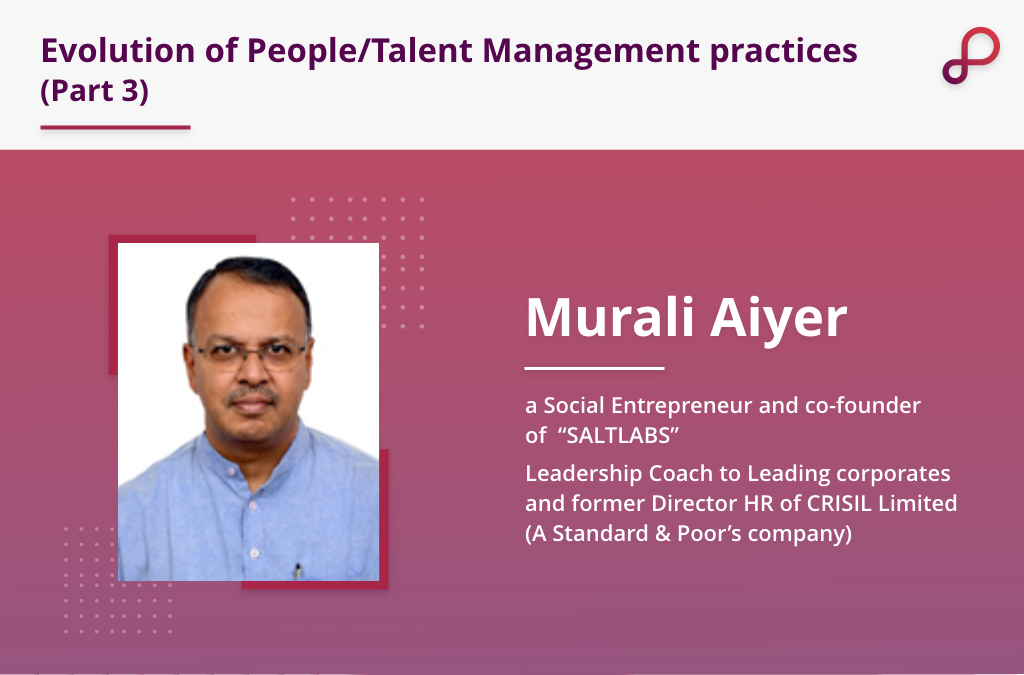10 Nov

Our first conversation was with Murali Aiyer, a Social Entrepreneur and co-founder of “SALTLABS”, Leadership Coach to Leading corporates and former Director HR of CRISIL Limited (a Standard & Poor’s Company)
Here’s what Murali shared with PossibleWorks when he was asked to speak on the Evolution of people/talent management practices. We also asked him to specifically address the following questions.
Q – Murali – I know this is close to your heart as you have been dealing with softer aspects of people, their competencies, and their talent development and incubation. You know things have changed in the last ten-fifteen years. Do you think that the focus of management across has increased when it comes to people’s issues? Or do you think it has come down?
No, no, I think it has increased – dramatically as such, and even more so in the virtual setting, and in the global setting that we have been working in. The abilities we look at – talent management as a holistic concept is now well-entrenched in the larger organizations. The precursor is, of course, the competencies. Based on that, they look at the changing needs of the business and the capabilities that they need to have.
Q- How is talent development executed in large organizations?
‘Large organizations typically have defined competencies on how they would like team members to get promoted – to get ready for an elevation, more responsibilities, and they would like such incubation’. Most of the leadership programs that we do are at least 8-9 months long. We offer executive coaching with conceptual inputs, and there is a live project, over and above an employee’s current project, which they have to deliver, where they demonstrate that they are ready for that kind of a lift-off. This systematic development is the only way they can augment the talent pipeline.
“Talent development through performance management is crucial for organizations to grow into new domains”
Q – Is Hiring for senior-most profiles advisable for organizations? Or like you mentioned that employees from within the system should be groomed to take on these positions?‘Getting talent from outside at the senior-most level is a huge gamble because the culture of these organizations is well-entrenched and the clients recognize that culture’. A new guy coming in at the senior-most level, very often or in most cases, fails to give the right results on the customer front, process front, as well as on the financial front. They are good in terms of consultants/experts but they need internal people to come in at the topmost level. The only way they can build their own talent pipeline is by using Ram Charan’s Model of Talent Pipeline. You may say ‘I want two people to head the two businesses,” that is at one level. Then if you want to look at talent augmentation, the talent pipeline needs to have that.Q – Can you elaborate on Talent augmentation and pipeline management?
Typically, if you pick up a fresher, the fresher will be good at a particular domain, and also demonstrate a capability to learn. You figure out that this person is a reasonably good employee, and then want to see if the person can lead a couple of other employees. Soon, he or she becomes the leader of a small team. The next step would be to lead a couple of managers, who have small teams themselves. At each of these intersections, the person has to stop doing certain tasks and start doing new tasks. Now, unfortunately, without a proper talent pipeline management process, the person starts doing new tasks, but never stops doing what he was doing and soon the bandwidth gets choked, and the person is actually doing work at one level down. At any level, when someone starts doing work at one or two levels down, everybody starts doing work at one or two levels down too. Now you can imagine the repercussions.
“Talent augmentation involves grooming in-house talent for roles at different levels”
So, if somebody needs to get elevated from a particular position, then it is going to impact the entire system. One needs to figure out that one guy who can go across and manage those tasks at different levels. If I don’t have that kind of a mechanism, then the guy’s role changes, his title changes, but he continues to do the same things. That’s when we’re setting ourselves up for a disaster and as Ram Charan beautifully says, “You need to train people at different levels of the pipeline.” And ‘in terms of what they need to start doing, what they need to stop doing, and what they need to continue to do. That is the foundation of the talent augmentation process’. Q – So, a talent pipeline has to be part of the organization or has to be groomed, both on the cultural dimension and the competency dimension.
This is the third part of the performance management system, which is about how we can improve. ‘So, to improve your people, you need to have a talent development process’. At each level – people always keep saying, the guys under me are not as good as they used to be when I was young. That simply reflects on the failure of leadership to recognize talent management as a critical, integral part of the organizational process. Large organizations, like an HDFC and others, if they don’t do this, they won’t be able to grow into newer domains.
Q – Do you think this is a well-recognized need across the industry, across sizes of organizations? Or do you think it is predominantly recognized by large organizations?
Predominantly by large organizations. The rest of them need to be educated on this. And if they are not educated on this, first of all, the leadership needs to understand its importance.
Q – If they don’t understand and develop those systems, to train their people for growth, then the organizational growth will be impacted. Right?
Yes. And many of them feel that they can buy the talent they need. As a person who’s been in the HR field for years, I’ve failed more often than I’ve succeeded.
Q – In getting outside talent, to succeed inside?
Yes!
Q – Do you believe that when talent is brought from outside, specific training or performance management systems provide quick reviews to understand what sort of training should be provided to these people, and get them to deliver what the role requires?
Yes, in fact, when talent is hired especially at a middle level or different levels, I would recommend they go through the first year, understanding the organization system. They should also go through specific training. As they go through it, they will identify the gaps. Very often, the talent that comes in is good on 30-40% which the organization does not have but weak on the 60-70% that the organization is strong in. Those need to be developed, especially in lateral talent. Otherwise, you run a risk.
Q – You mentioned you coach leaders in a large technology company. You mentioned that there has to be a culture where people adopt these technologies. What happens when people don’t find the bandwidth to learn how to use these technologies. Like you mentioned this person doesn’t have time to sit with his team for appraisals, similarly some people don’t find time to learn how to use technology.
You have to first and foremost tell him, ‘Boss, this is your job. In your job, technology is the medium and is not over and above your job. Technology is the platform on which you do your job’. Once this understanding is made clear to the employee, they can’t resist it.
“Talent development through performance management is crucial for organizations to grow into new domains”
If everything is in an employee’s mind and employees don’t have the attitude to adapt to technology, then the organization’s culture should weed out these prima donnas.Q – So, what you’re saying Murali is, these senior managers, (who are handling teams), have to realize that using that system to manage the performance of their teams is part of their jobs.
Yes! It is their job! And that is the way to do it. Today, an Uber driver who gets in the entire Uber system can’t tell you ‘sir, I cannot understand this Uber app’. Everything about his performance, his ability to quickly get a fare if he is in the same area – are all based on the Uber app. Let me tell you, you don’t need the education to understand technology. The average Uber car driver will tell you, “please give me a 5- (star) rating, sir. It impacts a lot of things.” This whole thing about technology being very hi-fi – is an overrated comment. It is a comment given by people who find excuses to avoid it. Today, we can’t avoid technology. If employees are irrevocably told that this is the way, they’ll take it up.
Q – So, as we discussed, talent management has to be very closely aligned with the way your performance management system is designed. That will gauge the competencies which are available, and which are lacking, and how to help the people grow and acquire relevant skills.
Correct. You ask any employee or their boss, they will tell you the same. The other thing is, before any talent management process, we take a 270-degree poll/feedback. Every leader who comes to us goes through a battery of instruments. One reveals their own preferences, the other one is about how they perform in a team, and the third is 270-degree feedback on their competencies. That input for a leader is very critical at the start. Otherwise, he or she can believe that they are God’s gift to the company.
That reality check has to be built in at the start. Having feedback like these integrated with talent management is really useful. As an HR guy, I’d be very interested in a process that starts with a 270-degree review and feeds into the competencies directly and shows you what the gaps are. That should be the basic requirement for all of us, as coaches. We start with that as the basic, first cut. And then we figure out further actions. Such feedback could throw up hundreds of things. We try to figure out the three or four root causes and pick up two where we can really make an impact.
Q – Do you think there are more resources – online resources – which can help employees develop their competencies?
Absolutely. For example, we were using Zoom. We found Zoom works best, especially when we want to have syndicate groups in breakout rooms. We explored other software tools and found one that effectively lent itself to a customized virtual-template building as a whiteboard mural. which lends itself to a lot of things. 5 people could write on the board at the same time, and we would know who is writing what and we can have teams working together. Typically, a bidding team, a contracts team, as well as an approach and methodology team who are working to bid for a project, all three can work together remotely, using such aboard. For this, they need to be able to collaborate. So, the capability to collaborate should be built up in them. They need to understand that each of them needs to turn around this project bid in three days. Typically, each team takes around three days to do it. So, it would take around 8-10 days to complete it. Let’s say they want to do a drone survey to understand the topography of the place where the project is being planned, each of the inputs can come to life, and they all can work using collaborative tools. Domain expertise today goes hand in hand with technology. The way we’re seeing it, talent needs to understand how to collaborate. Age is no longer relevant, you can have a 65-year-old retired retainer, and a 24-year-old project lead, and a 45-year-old set of consultants and advisors who are all part of a team, and they all need to have the capability to interface using technology.
Q – So, technology has become central.
Absolutely central.



